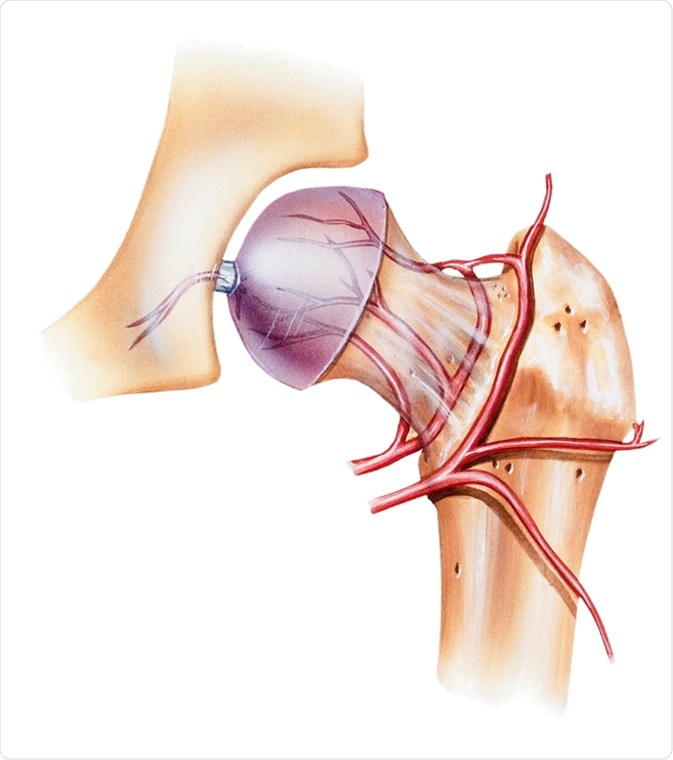Osteonecrosis is also called avascular necrosis of the bone. It refers to the condition in which part of a bone dies because its blood supply is interrupted.
All bones are made up of living cells, and therefore a steady supply of blood is essential to keep them healthy. A drastic reduction in the circulation to these organs can cause failure of repair mechanisms, leading to tiny breaks in the bone, or microfractures. The final outcome is the death of the bone cells, which in turn means the bone structure eventually collapses.
When bone collapses, the joints nearby break down as well under excessive pressure, resulting in osteoarthritis.
The process may be insidious, causing symptoms over a long period of time, such as arthritis, limitation of movement, and pain. The damage may be so severe as to require joint replacement.

Leg - Osteonecrosis of the Femoral Head front view. Shown are the round ligament and artery of the femoral head, medial circumflex femoral artery, and lateral circumflex femoral artery. - Illustration Credit: Medical Art Inc / Shutterstock
What causes osteonecrosis?
Osteonecrosis has more than one cause. The more commonly seen causes include:
- Severe injury which could cut off the circulation to a bone by damaging the blood vessels
- Systemic lupus erythematosus, an autoimmune disease which affects blood vessels, or antiphospholipid syndrome
- Nitrogen bubbles trapped within blood vessels, closing off circulation beyond their location – called the ‘bends’, or decompression sickness
- Disorders of the blood like sickle cell anemia
- Radiation therapy
Less frequent causes include:
- Fatty deposits in the blood vessels that feed the bones
- Steroid medications taken for a long period could increase fat levels in the blood and encourage fatty blockage of bone vessels
- Drinking too much alcohol could also operate the same way
- HIV infection
- Radiation therapy
- The use of bisphosphonates to strengthen the bone (in some bone cancers) can cause jaw osteonecrosis
- Organ transplantation
- Medical illnesses such as pancreatitis and diabetes
How is osteonecrosis diagnosed?
Localized bone pain should arouse the suspicion of osteonecrosis in at-risk patients. The pain associated with hip osteonecrosis is experienced as groin pain that worsens with walking or weight-bearing.
Following the clinical suspicion, X-rays of the painful area are advised, but may look normal at first. Other imaging studies include bone scans or magnetic resonance imaging , which is superior in detecting early osteonecrosis .
Management of osteonecrosis
Osteonecrosis should be treated as early as possible to optimize outcomes.
Conservative management
Early treatment is conservative: relieving the pain, using non-steroidal anti-inflammatory drugs (NSAIDs) and avoiding putting weight on the affected joints. This may mean using crutches, or restricting the amount one walks. If the osteonecrosis affects only a small area of the bone, this mode of treatment may be adequate.
Physical therapy may help keep the joint flexible and strong during this period.
Surgical management
If the bone necrosis is severe and collapse is imminent, surgical procedures will probably be required to relieve the pain and prevent collapse.
One such procedure is core decompression, where a piece of bone is removed from the innermost part of the affected area. This is done to relieve the pressure and provide space inside the bone, to encourage a healthier circulation and the growth of healthy bone tissue.
Another procedure is osteotomy, meant for more advanced disease, and involves the removal of dead bone. At the same time the weight-bearing surface is protected by reshaping the remaining bone, to create a healthy joint.
Yet another option is bone grafting, taking healthy bone bits from another site and transplanting them to the area of dead bone to promote better circulation and strength of the bone. Electrical stimulation may enhance bone growth to replace the dead bone.
However, in the presence of joint collapse, a total joint replacement or arthroplasty is often the only option to restore function and relieve pain.
Regenerative treatment
Regenerative treatment using bone marrow aspiration and injection of stem cells into the necrotic area is still under study.
Medical treatment
Medical treatment is largely ineffective, though bisphosphonates may be used for a short-term improvement of bone strength, or to prevent or at least slow down the rate of bone degeneration and collapse. However, bisphosphonate use has been cited as a risk factor for osteonecrosis development.
Blood cholesterol lowering agents and blood thinners may help to prevent vascular blockage related to necrosis.
Other preventive measures include avoiding alcohol and smoking and making sure that steroid dose and duration are minimized .
Further Reading